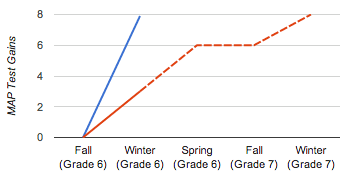
Program Overview
The teacher of the treatment classes required students to use Reflex one day per week in class and three days per week outside of class-time. The Reflex work was counted toward each student's participation grade. Additionally, the teacher sent regular emails to parents about their assignments, including Reflex, and had students graph their fluency weekly. This approach led to high levels of Reflex usage and high fluency gains for all her students.
Students spent the first part of the year working in multiplication and division 0-12 and subsequently moved on to shore up their fluency in addition subtraction 0-10 as well. Students started out fluent with approximately one-fourth of their multiplication and division facts. After an average of 50 days of Reflex, their fluency grew to an impressive 98%. In addition and subtraction, the same students went from 36% starting fluency to 96% with an average of 39 days of usage.
"It's so rewarding when you teach kids, many of whom had never ever passed a state math test, and they come up to you and say, 'Math is my favorite subject now!'"—6th Grade Math Teacher, SMS
Reflex Results Addition/Subtraction

Reflex Results Multiplication/Division

At the end of the year, results on state testing and national tests were analyzed and compared to those of students across the school district and the nation.
Outcomes
I had never seen MAP growth like that. I even had a Special Education student jump almost 4 grade levels in the number sense category.
—6th Grade Math Teacher, SMS
MAP Math Test Growth
The students who used Reflex grew an average of 7.9 points on the Measures of Academic Progress (MAP) math test in four months compared to the national average growth of 3.0 points.
The Northwest Evaluation (NWEA) MAP mathematics test is a nationally-normed, computer-adaptive assessment used in many US school districts. The test is typically administered multiple times during the school year to provide a detailed picture of each student's current mathematical level and to measure growth over time. Because the test is nationally-normed, educators can also compare their students' growth to that of other students across the country.
The Reflex-using students in this study took the MAP test in the fall and again in the winter. Growth for a typical 6th grader over this time period is 3 points. The Reflex-using students in this study gained an average of 7.9 points, more than double the national average. This level of growth, achieved in approximately four months, is equivalent what a typical 6th grader would attain in a year and a half of school. The impact was broad-based. Over the four-month period, the number of Reflex users in the lowest quartile nationally was reduced by half and the number in the top quartile more than doubled.
MAP Test Gains From Fall to Winter

Improvement on MAP Test: Reflex Users vs. National Average


State Math Assessment Gains
The results this year were incredible. My students leap-frogged the county's performance overall in pass rates, and I have lots of Advanced Pass students now as well!—6th Grade Math Teacher, SMS
The pass rate for the Reflex students increased from 50% in the prior year to 94% after using Reflex. Average district pass rates grew less, rising from 69% to 84%.
The Reflex-using group came into 6th grade with a substantially lower pass rate on their 5th grade state test than the district as a whole. Only half of them had passed the high stakes exam, compared to 69% district-wide. After a year with Reflex, they were able to close the gap and actually surpassed the district average. 94% of them passed the grade 6 test compared to 84% across the district. Additionally, while none of the Reflex users had passed the 5th grade test with an advanced score, 15% did so on the 6th grade test, once again exceeding the district average.
State Math Test Pass Rate Comparison


Sign up to get the latest updates from ExploreLearning via occasional email.